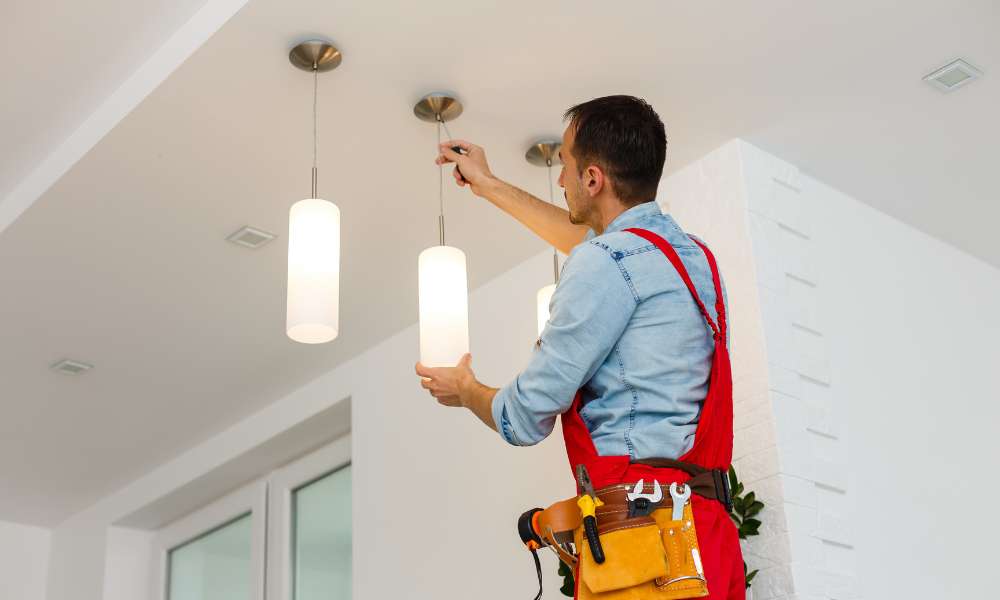Install Ceiling Lights is one of these domestic improvement obligations that can dramatically trade the atmosphere of a room with extraordinarily little effort. Whether you’re seeking to add some sparkle on your residing room or need centered lights for a workspace, know-how how to installation ceiling lights opens up a international of opportunities. Not best does it decorate the capability of your area, but it also offers an possibility to showcase your fashion. Plus, it’s a worthwhile DIY mission that everyone can tackle, furnished they comply with the right steps and use the right tools.
1. Essential Tools and Materials You’ll Need to Install Ceiling Lights

Before you begin, it’s crucial to gather all the necessary tools and materials. Having everything ready ensures a smooth and efficient installation process.
At the very least, you will need:
- Ladder: A sturdy ladder is essential for reaching high ceilings. It should be tall enough to give you safe access to the fixture without stretching.
- Screwdriver Set: A variety of screwdrivers, including flathead and Phillips, will be needed to remove existing fixtures and attach your new light.
- Wire Cutters and Strippers: These tools are indispensable for cutting and stripping wires when connecting your light fixture.
- Electrical Tape: To secure wire connections and prevent any chance of a short circuit.
- Voltage Tester: Ensuring the power is off is critical to safety. This tool helps verify that no electricity is running through the wires.
- Light Fixture: The piece de resistance! Choose a fixture that suits your aesthetic and functional needs.
Optional but helpful tools:
- Pliers: For bending wires or securing connections.
- Drill: If you need to make additional holes in the ceiling for mounting.
- Wire Nuts: For connecting the wires more securely.
By gathering these tools ahead of time, you’ll avoid unnecessary interruptions in the middle of your installation process.
2. Safety First: Important Precautions Before You Begin
Safety should always be your top priority when working with electrical systems. Remember, even a small mistake can lead to serious consequences. Here are key safety tips to follow:
- Turn off the Power: The most important step in any electrical work is to cut off the power supply at the circuit breaker. Use a voltage tester to ensure the wires you’re working with are not live.
- Wear Appropriate Clothing: Avoid wearing jewelry or clothing with loose sleeves, which can get caught on tools or electrical parts. Rubber-soled shoes are also a good idea to avoid any electrical conductivity.
- Check the Fixture’s Compatibility: Ensure your ceiling can support the weight of the fixture you’re installing. If necessary, consult the manufacturer’s instructions for weight limits and mounting requirements.
- Don’t Rush: Take your time and don’t try to cut corners. Working with electricity demands patience and attention to detail.
Once all safety precautions are in place, you’ll be ready to begin installing your ceiling light with peace of mind.
3. Step-by-Step Guide: How To Install Ceiling Lights with Ease

- Prepare the Installation Area: Start by removing any existing fixture. Carefully take out the old light by unscrewing it from the vault. Make sure to keep the screws for the new fixture if they are compatible.
- Connect the Wires: When dealing with ceiling lights, you’ll typically encounter three wires: the live (black), neutral (white), and ground (green or bare copper). Begin by connecting the corresponding wires from the ceiling to those in the light fixture. Use wire nuts to twist the wires together securely.
- Secure the Fixture: Once the wires are connected, attach the light fixture’s base to the vault. This may involve screwing the fixture into a mounting bracket, which is typically included with the new light.
- Install the Bulbs: After securing the fixture, install the bulbs that are recommended by the manufacturer. Always check the wattage to ensure they are compatible with your fixture.
- Test the Light: With the installation complete, turn the power back on at the breaker and test the light switch. If the light does not turn on, double-check your wiring and connections.
By following these steps, you’ll have a newly installed ceiling light that enhances your home’s lighting and style.
4. How To Choose the Right Ceiling Light for Your Space

Choosing the right ceiling mild includes thinking about both practical and aesthetic factors. Here’s what to keep in thoughts:
- Room Size and Purpose: In a small room, a flush-mount light may additionally suffice, while large rooms might benefit from chandeliers or pendant lights. Consider the reason of the room—mission lights, ambient lights, or accent lighting—and choose a fixture that suits.
- Height: Low vaults name for flush-mount or semi-flush-mount furnishings, while excessive ceilings can assist pendant lighting fixtures or chandeliers.
- Style and Design: Your vault mild have to supplement the general decor of the room. If you’re going for a modern, glossy appearance, a minimalist layout can be perfect. For conventional rooms, ornate chandeliers or sconces is probably extra appropriate.
In essence, choosing the right ceiling light requires balancing capability with aesthetics, making sure the fixture serves its purpose even as enhancing the room’s common appearance.
5. Installing a Ceiling Light: Single Fixture vs. Multiple Fixtures

Deciding whether or not to How To Install Ceiling Lights or a couple of furnishings depends on the dimensions of the room and the level of illumination wanted.
- Single Fixture: A single vault mild works properly for smaller rooms or regions wherein you don’t want vibrant, dispersed lighting. It’s an amazing desire for bedrooms or eating rooms.
- Multiple Fixtures: In large rooms, or in case you need brighter lighting, recall installing more than one fixtures. This may additionally contain a chain of recessed lighting or pendant lights which might be spaced frivolously during the ceiling. This guarantees consistent and sufficient lighting fixtures insurance.
Each choice has its execs and cons, so select the only that satisfactory suits your desires.
6. Common Mistakes to Avoid When Installing Ceiling Lights

While installing ceiling lighting fixtures is straightforward, some not unusual mistakes could make the process more complex or maybe dangerous:
- Incorrect Wiring: Always double-test your wire connections. Mixing up live and neutral wires can motive electrical issues or even fires.
- Not Using the Right Fixture: Ensure the light fixture you pick out is rated to your vault type. For example, heavy chandeliers require stronger ceiling helps.
- Neglecting the Power Supply: Forgetting to turn off the electricity on the breaker is a not unusual oversight that can result in electric shocks or worse.
Avoiding those mistakes will make sure a easy, safe, and successful installation.
7. Troubleshooting: What To Do If Your Ceiling Light Doesn’t Turn On
If your new ceiling light doesn’t work after installation, don’t panic. Here’s a quick troubleshooting guide:
- Check the Circuit Breaker: Sometimes, the circuit breaker may trip during installation. Ensure the breaker is in the ‘on’ position.
- Inspect the Bulbs: Ensure that the bulbs are correctly installed and not burnt out.
- Verify the Wiring: If the light still doesn’t turn on, check the wiring connections. Loose or improperly connected wires can prevent the light from functioning.
If these solutions don’t resolve the issue, it may be time to call in a professional.
8. Hiring a Professional vs. DIY: When To Call in an Expert for Ceiling Light Installation

While How To Install Ceiling Lights is generally a DIY-friendly task, certain situations may require professional expertise:
- Complex Installations: If you’re dealing with intricate lighting, such as chandeliers with multiple arms, it may be worth hiring a professional.
- Unfamiliar with Electrical Work: If you feel uncomfortable or unsure about working with electricity, calling a licensed electrician ensures safety.
- Structural Issues: If your ceiling cannot support the weight of the fixture, a professional can install additional support brackets.
In these cases, hiring an expert ensures the installation is done safely and efficiently.
9. Maintaining and Cleaning Your Ceiling Lights After Installation
Once your ceiling mild is mounted, everyday maintenance ensures it remains in top-rated condition. Here’s what you need to do:
- Clean Light Fixtures: Dust and dust can gather on mild furniture, dulling their appearance. Use a smooth, dry fabric to clean glass or metallic additives, and a mild cleanser for extra sensitive finishes.
- Check for Loose Connections: Periodically investigate the wiring and connections to make certain everything is secure and there are not any signs and symptoms of damage or fraying.
A little renovation is going a protracted manner in extending the existence of your ceiling lighting.
Conclusion
After following these steps and installing your ceiling mild, the consequences are certain to be satisfying. Not best have you brightened up your area, but you’ve additionally accomplished a worthwhile DIY mission. The right lighting fixtures can completely transform a room, creating a comfortable atmosphere or brightening up functional spaces. Now, sit again and experience your newly illuminated domestic!

